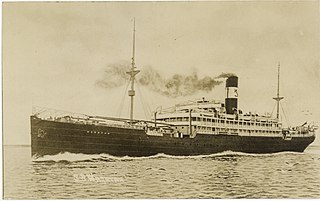
KwaZulu-Natal is a province of South Africa that was created in 1994 when the Zulu bantustan of KwaZulu and Natal Province were merged. It is located in the southeast of the country, with a long shoreline on the Indian Ocean and sharing borders with three other provinces and the countries of Mozambique, Eswatini and Lesotho. Its capital is Pietermaritzburg, and its largest city is Durban. It is the second-most populous province in South Africa, with slightly fewer residents than Gauteng.

Durban, nicknamed Durbs, is the third most populous city in South Africa after Johannesburg and Cape Town and the largest city in the South African province of KwaZulu-Natal. Durban forms part of the eThekwini Metropolitan Municipality, which includes neighboring towns and has a population of about 3.44 million, making the combined municipality one of the largest cities on the Indian Ocean coast of the African continent. Durban was one of the host cities of the 2010 FIFA World Cup.

CP Ships was a large Canadian shipping company established in the 19th century. From the late 1880s until after World War II, the company was Canada's largest operator of Atlantic and Pacific steamships. Many immigrants travelled on CP ships from Europe to Canada. The sinking of the steamship RMS Empress of Ireland just before World War I was the largest maritime disaster in Canadian history. The company provided Canadian Merchant Navy vessels in World Wars I and II. Twelve vessels were lost due to enemy action in World War II, including the RMS Empress of Britain, which was the largest ship ever sunk by a German U-boat.

SS Waratah was a passenger and cargo steamship built in 1908 for the Blue Anchor Line to operate between Europe and Australia. In July 1909, on only her second voyage, the ship, en route along the coast of the Colony of Natal from Durban to Cape Town, disappeared with 211 passengers and crew aboard. No trace of the ship has ever been found.

The Queen Nandi Mounted Rifles is an reserve armoured regiment of the South African Army.

Hinduism is practised throughout South Africa, but primarily in KwaZulu-Natal. Approximately 1.1% of the South African population professed to be Hindu, according to the 2011 census. This is down from the 1.4% based on the 1996 census. The 2016 General Household Survey measured a further decline to 0.9%.
INduna is a Zulu/Xhosa title meaning advisor, great leader, ambassador, headman or commander of a group of warriors. It can also mean spokesperson or mediator, as the iziNduna often acted as a bridge between the people and the king. The title was reserved for senior officials appointed by the king or chief and was awarded to individuals held in high esteem for their qualities of leadership, bravery or service to the community. The iziNduna would regularly gather for an indaba to discuss important issues.

SS City of Cairo was a British passenger steamship. She was sunk in the Second World War with heavy loss of life, most after the sinking, but before being rescued.

SS Clan Alpine was a UK steam cargo liner. She was launched in 1918 and sunk by a U-boat in 1943.

SS City of Johannesburg was a British cargo steamship that was sunk in 1942. She was built by Barclay, Curle & Co, of Whiteinch, Glasgow for Ellerman Lines Ltd, of London in 1920, being launched as SS Melford Hall. She was renamed SS City of Johannesburg in 1926 and registered in Liverpool.
Port Natal High School is a public co-ed high school for Afrikaans speaking learners. The school is located in Umbilo, a middle class suburb of Durban, KwaZulu-Natal, South Africa. It was founded in 1941 and is home to over 700 students from Grade 1 – 12.

The Natal Government Railways (NGR) was formed in January 1877 in the Colony of Natal.

The South African Railways Class A 4-8-2T of 1888 was a steam locomotive from the pre-Union era in the Colony of Natal.

RMS Nova Scotia was a 6,796 GRT UK transatlantic ocean liner and Royal Mail Ship. In World War II she was requisitioned as a troopship. In 1942 a German submarine sank her in the Indian Ocean with the loss of 858 of the 1,052 people aboard.

The Natal Railway 0-4-0STDurban of 1865 was a South African steam locomotive from the pre-Union era in the Natal Colony.

The Natal Government Railways 2-6-0TDurban and Pietermaritzburg of 1877 were two South African steam locomotives from the pre-Union era in the Colony of Natal.

The Natal Government Railways Class K 2-6-0T of 1877 was a South African steam locomotive from the pre-Union era in the Natal Colony.
SS Umona was a British cargo liner. She was built at Sunderland on the River Wear in 1910, survived the First World War and was sunk by enemy action off Sierra Leone, West Africa in 1941.
The following index is provided as an overview of and topical guide to Wikipedia's articles on recreational dive sites. The level of coverage may vary:

Recreational dive sites are specific places that recreational scuba divers go to enjoy the underwater environment or for training purposes. They include technical diving sites beyond the range generally accepted for recreational diving. In this context all diving done for recreational purposes is included. Professional diving tends to be done where the job is, and with the exception of diver training and leading groups of recreational divers, does not generally occur at specific sites chosen for their easy access, pleasant conditions or interesting features.















